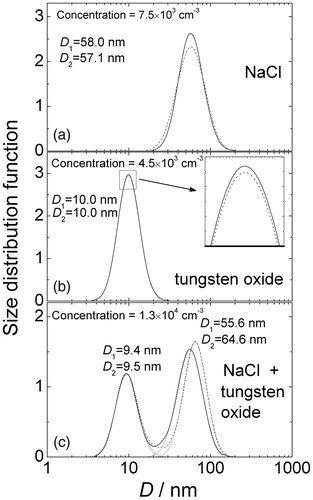Figures & data
Figure 1. Original model two-mode spectrum (EquationEquation (35)[35] , modal diameters D1 = 50 nm, D2 = 300 nm, and σ1 = σ2 = 1.4) (a), and spectra recovered analytically as the sum of lognormal functions EquationEquations (14)
[14] and Equation(15)
[15] with Di calculated numerically using EquationEquations (30)
[30] , Equation(33)
[33] , and Equation(34)
[34] (solution 1) (b), and EquationEquations (30)
[30] , Equation(34)
[34] , Equation(38)
[38] , and Equation(40)
[40] (solution 2) (c). The contributions from different fractions to the inversely calculated spectra are shown by vertical lines.
![Figure 1. Original model two-mode spectrum (EquationEquation (35)[35] , modal diameters D1 = 50 nm, D2 = 300 nm, and σ1 = σ2 = 1.4) (a), and spectra recovered analytically as the sum of lognormal functions EquationEquations (14)[14] and Equation(15)[15] with Di calculated numerically using EquationEquations (30)[30] , Equation(33)[33] , and Equation(34)[34] (solution 1) (b), and EquationEquations (30)[30] , Equation(34)[34] , Equation(38)[38] , and Equation(40)[40] (solution 2) (c). The contributions from different fractions to the inversely calculated spectra are shown by vertical lines.](/cms/asset/8c35c0dd-64a7-4064-a7f7-21eed51e3bbc/uast_a_1473839_f0001_b.jpg)
Figure 2. Mean single-fiber collection efficiencies for the spectrum EquationEquation (35)[35] (see ) as determined directly using the numerically calculated penetrations and formulas EquationEquations (17)
[17] and Equation(18)
[18] (spheres), using EquationEquation (32)
[32] (squares) and EquationEquation (37)
[37] (diamonds). Dash lines are spline interpolations of solid symbols.
![Figure 2. Mean single-fiber collection efficiencies for the spectrum EquationEquation (35)[35] (see Figure 1a) as determined directly using the numerically calculated penetrations and formulas EquationEquations (17)[17] and Equation(18)[18] (spheres), using EquationEquation (32)[32] (squares) and EquationEquation (37)[37] (diamonds). Dash lines are spline interpolations of solid symbols.](/cms/asset/db4527ba-1fe9-4d62-8738-77087531419c/uast_a_1473839_f0002_b.jpg)
Figure 3. Original model two-mode spectrum (EquationEquation (35)[35] , Modal diameters D1 = 50 nm, D2 = 300 nm, and σ1 = σ2 = 1.4) (a), and corrected analytical solutions 1 (b) and 2 (c). Dash lines are lognormal approximations for two main peaks of spectra b and c. The contributions from different fractions to the inversely calculated spectra are shown by vertical lines.
![Figure 3. Original model two-mode spectrum (EquationEquation (35)[35] , Modal diameters D1 = 50 nm, D2 = 300 nm, and σ1 = σ2 = 1.4) (a), and corrected analytical solutions 1 (b) and 2 (c). Dash lines are lognormal approximations for two main peaks of spectra b and c. The contributions from different fractions to the inversely calculated spectra are shown by vertical lines.](/cms/asset/9267d49a-5248-4b87-a39c-9937235379bf/uast_a_1473839_f0003_b.jpg)
Figure 4. Particle size distributions retrieved from diffusion battery measurements (corrected solutions) for aerosol of NaCl (a), tungsten oxide (b), and mixture NaCl + tungsten oxide (c). Solid line – solution 1, dash line – solution 2, dot lines are lognormal fittings of two-mode spectra components. D1 and D2 are geometric mean diameters for single-mode spectra (a and b) and for the components of two-mode spectra (c) for the solutions 1 and 2, respectively.

